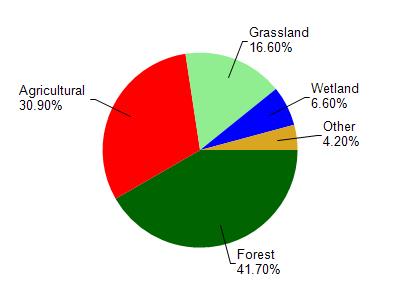Buffalo
No
No
No
Fish and Aquatic Life
Overview
Mirror Lake is an impoundment of the Brownlee and Peeso Creeks in Mondovi. See the Lower Buffalo River Watershed (BT07) map for its location. Mirror lake is approximately 30 acres and less than 10 feet deep. Little water quality information exists; however, the lake likely has characteristics similar to that of other Buffalo-Trempealeau Basin impoundments.
A self-help volunteer and Adopt-A-Lake participants on this lake could aid in documenting water quality trends and in increasing awareness about and protective actions for this lake. WDNR Watershed Management staff could collect other water quality data to build on past collection efforts.
Date 1996
Author Aquatic Biologist
Historical Description
Mirror Lake is a drainage impoundment having hard, alkaline, clear water of low transparency. The dam is privately owned and provides power. It has a height of 23 feet. The dam is located on Peeso Creek, but Brownlee Creek also enters the flowage from the north. Largemouth bass, bluegill, and black crappie are the primary sports fish. Brown trout, white crappie, bullhead, and green sunfish are also present. There are 2 public park areas and 35 dwellings. Muskrat numbers are significant in the biota. Mallards and teal nesting takes place and migrating waterfowl use the flowage.
Source: 1976, Surface Water Resources of Buffalo County Mirror Lake, T24N, R11W, S12 Surface Acres = 28.9, S.D.F. = 1.73, Maximum Depth = 7.0 feet.
Date 1976
Author Aquatic Biologist
Condition
Wisconsin has over 84,000 miles of streams, 15,000 lakes and milllions of acres of wetlands. Assessing the condition of this vast amount of water is challenging. The state's water monitoring program uses a media-based, cross-program approach to analyze water condition. An updated monitoring strategy (2015-2020) is now available. Compliance with Clean Water Act fishable, swimmable standards are located in the Executive Summary of Water Condition in 2018. See also the 'monitoring and projects' tab.
Reports
Management Goals
Wisconsin's Water Quality Standards provide qualitative and quantitative goals for waters that are protective of Fishable, Swimmable conditions [Learn more]. Waters that do not meet water quality standards are considered impaired and restoration actions are planned and carried out until the water is once again fishable and swimmable
Management goals can include creation or implementation of a Total Maximum Daily Load analysis, a Nine Key Element Plan, or other restoration work, education and outreach and more. If specific recommendations exist for this water, they will be displayed below online.
Monitoring
Monitoring the condition of a river, stream, or lake includes gathering physical, chemical, biological, and habitat data. Comprehensive studies often gather all these parameters in great detail, while lighter assessment events will involve sampling physical, chemical and biological data such as macroinvertebrates. Aquatic macroinvertebrates and fish communities integrate watershed or catchment condition, providing great insight into overall ecosystem health. Chemical and habitat parameters tell researchers more about human induced problems including contaminated runoff, point source dischargers, or habitat issues that foster or limit the potential of aquatic communities to thrive in a given area. Wisconsin's Water Monitoring Strategy was recenty updated.
Grants and Management Projects
Monitoring Projects
| WBIC | Official Waterbody Name | Station ID | Station Name | Earliest Fieldwork Date | Latest Fieldwork Date | View Station | View Data |
|---|
| 1820900 | Mirror Lake | 10001037 | Mirror Lake (Buffalo County) | 8/29/2000 | 9/25/2013 | Map | Data |
| 1820900 | Mirror Lake | 10015102 | Mirror Lake Mini Fyke Nets | 4/24/1980 | 10/16/1980 | Map | Data |
| 1820900 | Mirror Lake | 10015058 | Mirror Lake Ibi | | | Map | Data |
| 1820900 | Mirror Lake | 10018604 | Mirror Lake -- Access | 6/21/2023 | 6/21/2023 | Map | Data |
|

Watershed Characteristics
Mirror Lake is located in the Lower Buffalo River watershed which is 275.43 mi². Land use in the watershed is primarily forest (41.70%), agricultural (30.90%) and a mix of grassland (16.60%) and other uses (10.80%). This watershed has 637.77 stream miles, 890.60 lake acres and 9,906.82 wetland acres.
Nonpoint Source Characteristics
This watershed is ranked High for runoff impacts on streams, Not Available for runoff impacts on lakes and High for runoff impacts on groundwater and therefore has an overall rank of High. This value can be used in ranking the watershed or individual waterbodies for grant funding under state and county programs.However, all waters are affected by diffuse pollutant sources regardless of initial water quality. Applications for specific runoff projects under state or county grant programs may be pursued. For more information, go to surface water program grants.